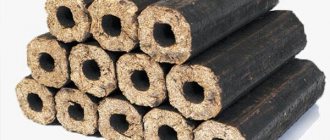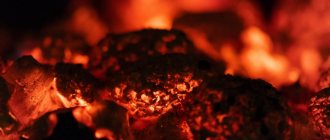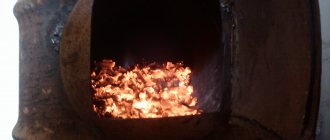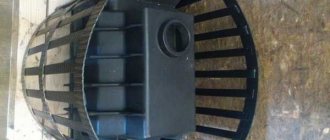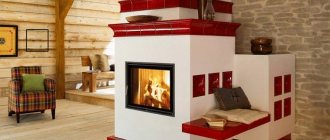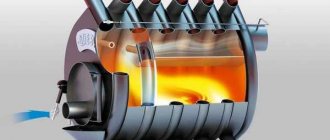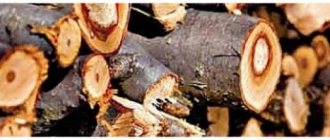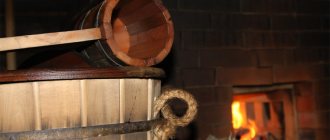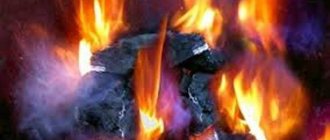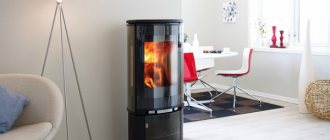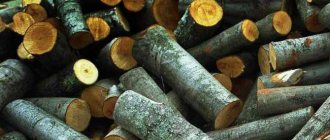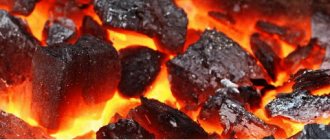One of the events in all pioneer competitions was the ability to light a fire. Years have passed, but we remember many of the subtleties associated with this process. From a physics point of view, for the combustion process it is necessary to provide access to oxygen and remove combustion products. These two principles are implemented in any fireplace and any stove using design features.
A real fireplace, regardless of its type, is based on the release of heat when fuel burns. The characteristics of the fireplace, including its efficiency, are constant parameters depending on the design of the device and the material. But under all the same conditions, fireplaces can produce different amounts of heat. It turns out that it all depends on how you light the fireplace.
Filling the house with warmth and comfort
What is a fireplace stove?
The appearance of fireplace stoves on the heating appliance market has become a real boon for summer residents and owners of temporary residences. Previously, they had to choose between fast warm-up and high efficiency. An open fireplace, which in a few minutes turns the glacier into a comfortable room for living, is very voracious. Firing with wood requires a lot of attention: if you miss the time of the next bookmark, the fire will go out and the room will cool down as quickly as it warmed up. The efficiency of most modern stoves exceeds 50%, and the intensity of fuel combustion in them is well regulated. But the fast warm-up mode can not be configured on all models.
The fireplace stove is a hybrid heating unit that does not have these disadvantages. The intense combustion of the first bookmark allows you to quickly deliver a large amount of heat into the room. After additional loading, the fireplace stove can be switched to a long-burning mode, maintaining heat release at a level that compensates for heat loss.
The main differences in the design of this unit from a traditional fireplace:
- glass door equipped with a locking mechanism that ensures a tight fit;
- flame breaker - a metal plate that changes the direction of movement of exhaust gases, that is, it organizes smoke circulation.
The main difference from a traditional chimney stove is its lighter weight, which does not require installation on a foundation. At the same time, the design of the fireplace stove retains the blower door and smoke channel damper. Many models are equipped with functions for supplying secondary and tertiary air and self-cleaning glass.
Art Fireplace is the official supplier of fireplaces from famous companies. Among other things, they make their own mantels for fireplaces. The company has real design professionals on its staff. This allows them not only to sell and install fireplaces, but also to create a unique “image” for them.
On the Internet you can find the art fireplace website, which has the entire model range and detailed descriptions for each product. As for the cladding, it can be entirely transferred to the shoulders of the company’s craftsmen. They have enormous experience, which allows them to speak openly about their professionalism in this field.
More than 15 years on the market of this type of equipment has allowed them to successfully establish themselves and acquire a good reputation. The wide range includes both electric fireplaces and classic fireplaces. Moreover, even antique fireplaces can be supplied.
In its original design, the fireplace assumed the presence of a protrusion on top, which was called a mantelpiece. So, art fireplace also produces these shelves; you just need to agree on the design and size. Thus, we will focus on the products provided:
- Fireplace inserts, their installation and cladding according to the customer’s taste.
- Stoves and fireplaces. Their installation is also carried out, and various fire-resistant materials will be offered for cladding: brick, ceramics, tiles, marble, etc.
- A wide variety of accessories for fireplaces.
It is worth saying that this company supplies fireplaces from different countries, such as England, USA, Germany and the Czech Republic. Czech fireplaces, by the way, are rapidly increasing their popularity. Most of them are made from natural materials. Czech craftsmen try to make each of their creations unique and inimitable. Their products can even be called one-piece, since each fireplace is individual and not like the others.
Necessary accessories
You need to prepare for the first kindling in your life. There are a few seemingly insignificant things that should be on hand when you start lighting a fireplace in your home:
- Poker . It needs to reach the back wall and the far corners of the firebox, then it will be comfortable for her to work.
- Scoop . It should be light, non-flammable, and fit across the width of the ash drawer door. When choosing, pay attention to metal scoops: they meet all the requirements.
- Canvas mittens . The fire door handle, poker and scoop can become very hot. Canvas mittens will protect your skin from burns and are comfortable to work in. Cloth vachegs, for example, are significantly inferior to them in terms of comfort. They are convenient for holding a thick crowbar, but not a poker.
Fireplaces "Supra"
Having listed several companies that supply various fireplaces, let’s take a closer look at the world-famous manufacturer. Since the nineteenth century, the French began mass production of equipment for space heating.
Built-in fireplaces from this company are real works of art. They have a predominantly classic look that will appeal to any, even the most discerning, buyer. But the range also includes electric heating fireplaces. Double-sided fireplaces began to be produced not so long ago, but due to their advantages and excellent heating properties they continue to gain a foothold in the international market.
Supra fireplaces also have decent cladding. Most often it is made of marble. Natural stone, of course, costs quite a lot of money, so the company’s craftsmen also offer artificial stones, which in appearance hardly differ from their natural counterparts. Official suppliers, such as Art Tone fireplaces and Global Fireplace, also sell the products of this company.
Chimney inspection
A chimney clogged with soot will never have good draft. Soot and tar on the internal surfaces reduce the flow area of the pipe and prevent the free movement of flue gases. After the furnace has been idle for a long time, moisture accumulates in the loose soot, and draft will not be established until it has completely evaporated. In addition, such deposits often lead to a fire inside the chimney, which is almost impossible to extinguish. Therefore, before lighting the fireplace, you need to make sure that the chimney is ready for use.
If the pipe is straight, you can use a mirror to inspect it. If it changes its direction, then there should be an inspection hatch at the turning point. It is also necessary to ensure the integrity of the chimney - there are no cracks at the joints.
The chimney should be cleaned before and during the heating season. The most effective way to remove deposits is mechanical. A brush that matches the diameter of the pipe will remove all dirt from the inner walls.
Preparation
Before dealing with fire, you should prepare the fireplace for use. Even if you heat it daily, still do not neglect this step for your safety.
- It all starts with a chimney inspection. The accumulation of soot on its walls can lead to uncontrolled combustion, that is, to a fire. Soot contains flammable resins and a substance called creosote. They need to be disposed of in a timely manner.
- While the fireplace insert is not filled with wood, you should check the draft. This is easy to do if you set fire to a piece of old newspaper. If there is draft, the fire flame will clearly deviate towards the chimney.
Each owner independently determines what to light the fireplace with, but there are a number of tips that you need to heed. Each of us has wondered why dry wood burns better. Damp firewood contains moisture between the fibers. It is necessary to transfer the amount of heat for a long time so that it completely evaporates, and only then the firewood will ignite.
Dry firewood, ready to use
Therefore, if you have a wood-burning fireplace, you should use only dry logs, preferably hardwood. Of course, you can melt it with wet wood, but it will require a lot of effort from you. A freshly felled tree is suitable for firewood after a year of proper drying, so owners of wood-burning fireplaces have pre-prepared supplies in woodpiles.
Good to know: Built-in fireplaces: main types, features of selection and installation
There are also certain requirements for the external parameters of firewood. Their length should not exceed 40 cm and be about ¾ of the width of the firebox. As for specific breeds, preference should be given to those that provide more heat. Examples include beech, yew, oak, and birch. It is not recommended to use coniferous trees, as the resin they contain will produce a lot of soot and smoke.
Preparing the firebox
The algorithm for preparing fireboxes is the same for all solid fuel heating devices:
- We take out everything that can be taken out: the “armor”, the grate, the ash drawer.
- We inspect the surfaces for cracks, burns and contamination.
- We make sure that the smoke damper, the secondary air supply damper, the hinges and locks of the glass door are working, and we check the tightness of the latter.
- We clean all accessible surfaces using a scraper and brush, and remove the ash.
Most manufacturers of metal stoves and fireplace stoves recommend calling service specialists to inspect the stove and chimney before the start of the heating season.
Checking traction
If the flame of a lit match or splinter deviates towards the exit of the flue gases, everything is in order with the draft. Otherwise, it will have to be stabilized, otherwise it will not be possible to light a fireplace without smoke. Natural draft depends on many factors, including the strength and direction of the wind, atmospheric pressure, humidity and others. But we can influence only one of them - the difference in temperature outside and inside the chimney.
If the room where the fireplace is located is warmer than outside, problems usually do not arise. There is already a temperature difference. Otherwise, we recommend using one of the following tips:
- Use a hair dryer. To do this, you need to cut a plywood panel that will completely cover the firebox opening, and make a hole in it the same size as the hair dryer nozzle. A stream of hot air will quickly warm up the firebox and remove the so-called air lock from the chimney.
- Open the chimney inspection hatch and burn several bundles of newspaper in it. You can also heat the chimney through the firebox. You need to bring the torch as close as possible to the outlet pipe.
- Place a burning candle in the firebox, close the firebox door and open the vent slightly. Warming up will take about half an hour.
One of the conditions for stable draft is normal supply ventilation. The room where the fireplace stove is installed should not be tightly sealed.
How to light a stove correctly
Most of us think that lighting a stove is very simple. He threw in some wood, added some paper, set it on fire and that was it. Actually this is not true.
Preparing the oven
First you need to clean the firebox and chimneys from soot and seal all the cracks. Then check that you have a poker, a scoop for removing ash, and thick mittens to protect your hands from burns.
Pre-prepared fuel must be dry. Steam from wet fuel condenses on the walls of the furnace channels and cools them. Coal for the fire must be of high quality and free of dust.
Next, we check the draft in the oven. After opening the chimney damper, you can simply put your hand inside the firebox. If you feel a puff of air, then everything is fine. You can also check the draft with a burning match or paper.
After making sure there is traction, we clean the grate and ash pan.
Furnace firing stages
After preparation, we begin to fire the stove. Main stages of working with fuel:
- Kindling . Dry residues from cutting firewood and working with wood are suitable for kindling: wood chips, shavings, birch bark and small brushwood. Chips can be cut with a knife from small dry logs. The kindling is placed on crumpled newspaper, several large logs are added on top so that the firebox is filled to a third of its height, and it is set on fire.
- Main bookmark submission . The first portion of fuel is placed tightly, covering the entire area of the grate. Subsequent bookmarks should be placed on large coals from previous portions. There must be at least 100 mm from the surface of the fuel to the top of the firebox. The furnace door closes, and the blower door opens slightly. The air supply is regulated by furnace valves.
- Combustion process . With proper air supply, the flame is straw-colored and the burning wood crackles slightly. If the flame is white and the firebox is humming, you need to reduce the air supply. If the fire turns dark red and smoke appears, increase the air supply. Logs of the same size burn perfectly. To obtain heat, it is necessary to adjust the damper on the chimney, the damper and the ash door, trying to prevent carbon monoxide from entering the room, but also without releasing all the heat from the combustion.
- Completion . When the open flame disappears above the coals, you need to half-close the damper and use a poker to move the remaining coals to the center of the grate. After the flame completely disappears, close all the doors and the view damper completely. If you don’t have time to wait for the coals to burn, remove them from the firebox and close the dampers and valves.
Safety regulations
The main hazards when using furnaces are carbon monoxide and fire. For safety reasons, follow a few rules:
- inspect the stove before lighting for traces of soot;
- do not use flammable liquids for ignition;
- finish heating 2 hours before bedtime;
- Use fuel that is suitable for this type of stove.
In conclusion, we note that brick stoves are heated to the maximum, and metal stoves - in small portions to avoid warping of the body.
Preparing fuel
Most fireplace stoves are designed to burn wood. But there are also models that can operate on coal and fuel briquettes. In any case, you will have to light the fireplace stove with wood, and switch to the “main” fuel from the second bookmark. And for this they need to be properly prepared:
- Trees are cut down in late autumn or winter, when the flow of sap stops.
- Pay attention to the depth of the firebox: finished firewood should not protrude outward. The maximum log length for a factory stove-fireplace is indicated by the manufacturer in the user manual. The logs are cut to this size.
- To achieve the required humidity, the logs are split and stored under a canopy until the next heating season.
- The firewood is dried indoors. This may take from 1 to 3 days (depending on outdoor storage conditions).
If the residual moisture content of the wood is more than 20%, lighting the fireplace without smoke will be problematic. In addition, evaporating water will condense on the internal stacks of the chimney and cause soot to settle.
Lighting up a fireplace stove in the classic way
Lighting the stove in the classical way implies the spread of combustion from the bottom (from the grate) to the top. The first filling is carried out in the following order:
- a lump of crumpled paper or a mound of birch bark;
- thin chips with a diameter of up to 1 cm;
- small logs (up to 3 cm).
The wood is not laid too tightly so that air can flow freely into the gaps. To light a fireplace without smoking, it is important not to overload the firebox. The first tab should occupy about 10% of its volume. After the paper catches fire, you need to carefully (without slamming) close the fireplace door. In this case, the vent should be slightly open.
Firewood of regular thickness is laid after the wood chips have completely burned out. There should be hot coals with some flame left. An attempt to lay thick logs immediately often leads to the fact that the combustion products of the paper cool down and do not have time to heat the wood chips to the ignition temperature. This is accompanied by intense smoke and sometimes stalling of the draft. Often massive logs located on top sag and disrupt the structure of the bookmark.
Proper fireplace lighting
It is not recommended to completely remove the ash remaining from the previous kindling. Since it will reflect heat, it will also protect the walls of the fireplace from excessive heating and prevent cold air from entering from below. Before lighting, you should put newspaper and paper in the fireplace, which will help you quickly light the fire. It is necessary to place dry thin branches on the grate to speed up the process. It is better to place the logs with an inclination towards the room so that the heat goes into the room and not the chimney.
We use pieces of paper to better ignite the first flame
The easiest way to start lighting a fireplace is with rolled paper. First, when it lights up, you should bring a torch to the chimney to check the draft. Then set fire to the newspaper under the grate, after which the flames will engulf the logs. You need to watch the sparks so that they don't fall on the floor. If your fireplace has a safety door, you can close it. True, in this case the amount of heat generated by the fireplace will decrease. As the flame weakens, the firewood needs to be straightened with a poker or special tongs. New logs are added approximately every 30 minutes. They are placed further into the firebox, and the dying logs are dragged to the front edge.
It is recommended to calculate the burning time in such a way as not to resort to forced extinguishing of firewood. It's better to wait until they burn out on their own. Is it possible to leave a fire unattended? It is not advisable to do this. After the combustion ends, you can remove some of the ash using a brush and dustpan. We should not forget about systematically checking the condition of the chimney and periodically cleaning it from soot.
Top burning kindling
There is an alternative way of stacking firewood to light a fireplace, in which combustion occurs from top to bottom. The stacking begins with the thickest logs, wood chips are placed on top, then birch bark and paper. With this method, the firebox can be filled approximately 2/3 full. Even if the stove is cold and the draft is uncertain, the paper, which is located almost at the very outlet pipe, will warm up the chimney.
A prerequisite for starting kindling is that the ash pan must be tightly closed so that combustion air flows through the open opening of the fuel channel. When the draft stabilizes, you can open the blower and lock the glass door. After the bookmark burns out, a new portion of firewood is loaded. The fireplace stove is already warm enough. Therefore, if the room also becomes warm, it can be switched to long-burning mode.
To clearly demonstrate how to properly light a fireplace without smoke with an alternative stacking of firewood, we recorded a video that shows in detail all the nuances of this method. You can ask any questions you are interested in in the comments to the video by subscribing to our channel on YouTubeFornaksFilm
